
Baltic Germans are ethnic German inhabitants of the eastern shores of the Baltic Sea, in what today are Estonia and Latvia. Since their resettlement in 1945 after the end of World War II, Baltic Germans have markedly declined as a geographically determined ethnic group in the region.
An estate is a large parcel of land under single ownership, which generates income for its owner.

A manor house was historically the main residence of the lord of the manor. The house formed the administrative centre of a manor in the European feudal system; within its great hall were usually held the lord's manorial courts, communal meals with manorial tenants and great banquets. The term is today loosely applied to various English country houses, mostly at the smaller end of the spectrum, sometimes dating from the Late Middle Ages, which currently or formerly house the landed gentry.

Rawdon is a village and civil parish in the metropolitan borough of the City of Leeds, West Yorkshire, England. It sits on the River Aire and on the A65 south of Yeadon.

Svinia is a village of some 1,500 people in eastern Slovakia about 8 kilometres (5.0 mi) west from Prešov. The village covers an area of 14.734 square kilometres (5.689 sq mi). Svinia is located in the Šariš Highlands in the valley of Veľká and Mala Svinka. The village is one of the oldest villages in the former Šariš County. The village belonged to the Hungarian Merše family from Budapest from 1262 to 1918. Until 1262, the settlement of Svinia belonged to Bár-Kalán ban of Slavonia.
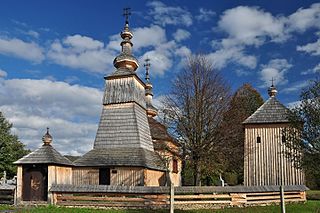
Ladomirová is a village and municipality in Svidník District in the Prešov Region of north-eastern Slovakia.

Tiszadada is a village in Szabolcs-Szatmár-Bereg county, in the Northern Great Plain region of eastern Hungary.

Saunags is a populated place in Kolka Parish, Talsi Municipality, Latvia, located 10 kilometres (6.2 mi) from the Cape Kolka, within the borders of Slītere National Park. The name derived from Livonian Sǟnag – pike perch (Sander), a local fish. First mentioned in documents in 1310, it is the oldest of the twelve Livonian villages on the Livonian Coast. It consists of two parts - Saunags and Dižsaunags, the later being the oldest and more preserved one. Located along the coast of the Baltic Sea and formerly inhabited by Livonian people.
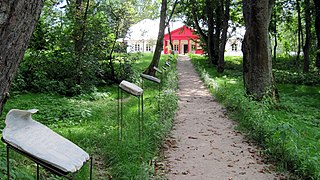
Krasnogruda is a village in the administrative district of Gmina Sejny, within Sejny County, Podlaskie Voivodeship, in north-eastern Poland, close to the border with Lithuania.
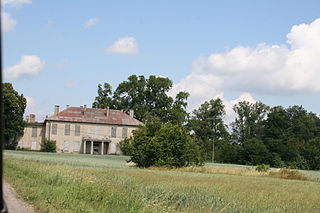
Czyste is a village in the administrative district of Gmina Inowrocław, within Inowrocław County, Kuyavian-Pomeranian Voivodeship, in north-central Poland.

Łopatki is a village in the administrative district of Gmina Książki, within Wąbrzeźno County, Kuyavian-Pomeranian Voivodeship, in north-central Poland.

Jaunauce Manor is a manor house in Jaunauce parish in Saldus municipality in the historical region of Courland, in western Latvia.
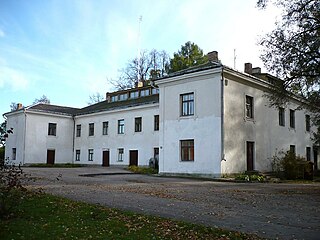
Lielzalve Manor is a two-storey manor house built in the 19th century in Zalve Parish, Nereta Municipality in the historical region of Selonia, Latvia.

Mercendarbe Manor, also called Mercendorf Manor and Mercendarbe Manor is a manor house in the historical region of Zemgale, in Latvia.

Reņģe Manor, also called Ruba Manor, is a manor house for the von Nolcken family that was built between 1881 and 1882 in the historical region of Zemgale, in Latvia. It is located about 2.5 km west of both the village of Ruba and the railroad bridge where the Glūda–Reņģe Railway crosses the Vadakste river along the border of Latvia and Lithuania. Manor building currently houses the Ruba Elementary School.
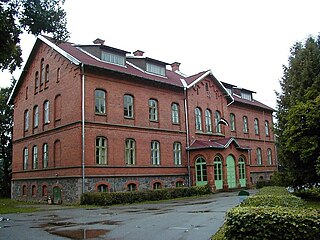
Skaistkalne Manor, also called Šēnberga Manor, is a manor house in the historical region of Zemgale, in Latvia. It is located in the village of Skaistkalne near the Mēmele River on the border of Latvia and Lithuania.
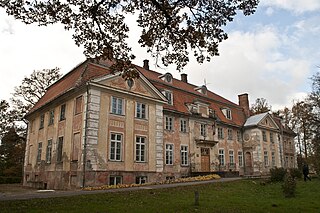
Ozolmuiža Manor is an Early Classicism style manor house built for Count George Johann von Mellin at the end of the 18th century in the historical region of Vidzeme, northern Latvia.

Mežotne Palace is a manor house located in Mežotne municipality in Bauska district, in the Semigallia region of Latvia. The palace is one of the most outstanding examples of Neoclassical architecture in Latvia.

Vácrátót is a village and commune in the comitatus of Pest in Hungary.
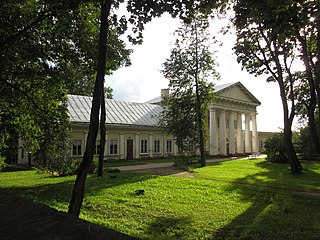
Salos Manor is a former residential manor in Rokiškis district municipality, Lithuania.





















